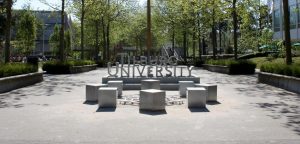Sensor technology at Carmel College
How comfortable and healthy are our classrooms for our students? How can we gain more insight? And how can we improve air quality? That’s what the Carmel College Foundation board asked SPIE Netherlands when it came knocking to reach
its ambition of reaching class B in the Frisse Scholen programme, which was set up to make schools more sustainable. Since not all schools were equipped with the necessary building technology to gain insight into technical comfort levels, we went looking for a solution and ended up suggesting that a sensor be installed in all classrooms to accurately track temperature, carbon dioxide levels and relative humidity. The Carmel College Foundation then developed a colour-coded map highlighting the schools that were most urgently in need of improvement. As of mid-November 2020, classrooms in the most critical locations have all been equipped with a sensor.

Real-time insight
All sensors can be accessed via a QR code, so you can request data on temperature, humidity and carbon dioxide levels straight from your device. The sensors also trigger an alert when carbon dioxide levels are too high, with their lights changing colour. Teachers can then intervene immediately, such as by opening a window.
Moreover, the measurement data collected by these sensors is also sent to our PULSE CORE Core data platform, which can analyse the building data and convert it into actionable information for us and Carmel College. This gives them real-time access to temperature, carbon dioxide levels and relatively humidity in all of there schools. PULSE CORE Core is ISO 27001-certified, guaranteeing information security.

Converting data to information
In the first phase, we focused our efforts on installing the sensors, while also putting ample thought into how to interpret the data we received. Worksphere drew up a detailed plan for data interpretation to serve the following objective: understanding how the climate systems in the schools perform in relation to indoor climate specifications set out in the Class B air quality acceptance criteria of the Frisse Scholen programme.
Carmel College also wished to identify systems that were unable to meet these acceptance criteria and what technical solutions could be found to make them compliant. Finally, through the contract, the Foundation wished to gain more insight into expected costs involved in optimising the air conditioning systems, in order to ultimately implement technical solutions that actually meet the Class B air quality acceptance criteria of the Frisse Scholen programme. Key success factors include a short lead time and the lowest possible costs.

Want to know more about using sensor technology at Carmel College? Kevin Breden and Leon Koppelman would be happy to help.


